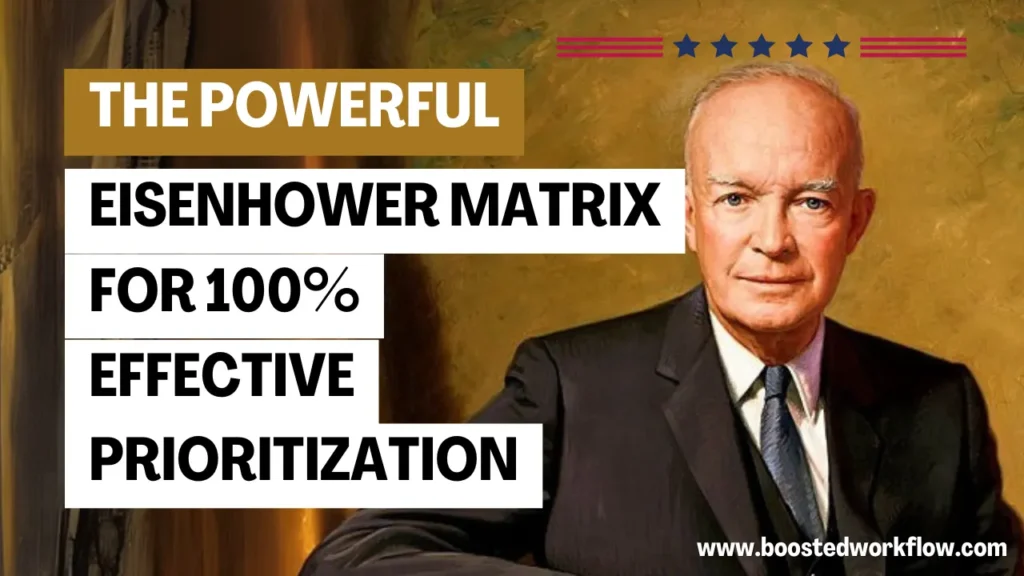Physical Address
304 North Cardinal St.
Dorchester Center, MA 02124
Physical Address
304 North Cardinal St.
Dorchester Center, MA 02124

In the cacophony of modern life, where tasks pile up faster than they can be completed, managing priorities becomes a herculean challenge. It’s easy to feel overwhelmed, chasing deadlines while losing sight of what truly matters. Amidst this chaos, a deceptively simple yet profoundly effective tool emerges: the Eisenhower Matrix. This matrix, developed from the insights of one of history’s most productive figures, offers a structured approach to regaining control over our time and energy.
Prioritization is not just a productivity tactic; it is a life skill. When mastered, it can lead to greater achievements, reduced stress, and a clearer focus on long-term goals. Let us unravel how the Eisenhower Matrix can revolutionize the way we approach our responsibilities.
“What is important is seldom urgent, and what is urgent is seldom important.” – Dwight D. Eisenhower

Origin and background: President Eisenhower’s productivity secret
The Eisenhower Matrix traces its roots to Dwight D. Eisenhower, the 34th President of the United States, renowned for his incredible ability to juggle immense responsibilities. As a five-star general during World War II and later as President, he made countless critical decisions daily. Eisenhower famously noted, “What is important is seldom urgent, and what is urgent is seldom important.” This philosophy laid the foundation for the matrix that bears his name.
The four quadrants explained
At its core, the Eisenhower Matrix categorizes tasks into four quadrants based on urgency and importance:
Visualizing the matrix: A breakdown of its structure
The matrix is a simple 2×2 grid. The top rows prioritize “Urgency,” while the columns focus on “Importance.” Visualizing tasks within this structure highlights which activities deserve your attention, empowering you to act with intention.

The psychology of decision-making and prioritization
Human decision-making is often driven by immediate needs, a cognitive bias known as hyperbolic discounting. This tendency can lead us to prioritize urgent tasks, even if they lack significance. Understanding this bias is key to overcoming it.
How urgency biases can derail productivity
Urgency biases make us susceptible to “firefighting” mode, where we address crises instead of working proactively. This cycle creates an illusion of productivity while diverting energy from impactful endeavors.
Why focusing on importance drives long-term success
Shifting focus from urgency to importance fosters deliberate action. Investing in activities that align with long-term goals leads to sustained success and personal fulfillment.

Step-by-step guide to setting up your matrix
Identifying tasks for each quadrant
Identify Quadrant 1 tasks by their high stakes, Quadrant 2 by their strategic value, Quadrant 3 by their tendency to distract, and Quadrant 4 by their insignificance.
Tools and templates to make the process easier
Digital tools like Trello, Notion, or dedicated Eisenhower Matrix apps simplify the process. Printable templates also work for hands-on planners.

The power of Quadrant 2: Long-term planning and growth
Focusing on Quadrant 2 transforms lives. It’s where personal development, relationship building, and innovation thrive.
How to handle urgent and important tasks without burnout
Tackle Quadrant 1 tasks strategically by breaking them into manageable steps. Avoid burnout by limiting time spent in this quadrant.
Strategies for delegating or automating Quadrant 3 tasks
Outsource tasks like routine emails or minor errands. Tools like automation software can further streamline repetitive activities.
The art of eliminating or saying no to Quadrant 4 distractions
Consciously eliminate Quadrant 4 activities by identifying triggers and setting boundaries. Saying “no” to time-wasters is an act of self-respect.

Personal productivity: Managing your daily to-do list
Use the matrix daily to organize your tasks, ensuring your energy is channeled into meaningful pursuits.
Professional use cases: Project management and team workflows
Teams benefit from the matrix by clarifying roles and focusing on impactful objectives.
Using the matrix for family and personal life balance
Apply the matrix to prioritize family commitments and personal hobbies, striking a balance between work and home.

Confusing urgency with importance
Many fall into the trap of addressing urgent tasks indiscriminately. Always evaluate a task’s impact before acting.
Overloading one quadrant and neglecting others
Balance is essential. Overloading Quadrant 1 leads to stress, while neglecting Quadrant 2 stunts growth.
Ignoring regular reviews and updates to your matrix
A static matrix loses relevance. Regularly review and adjust your priorities to stay aligned with evolving goals.

Scheduling time for matrix planning
Dedicate 10-15 minutes daily to review and update your matrix. Consistency is the key to mastery.
How to integrate the matrix into digital tools
Sync your matrix with tools like Google Calendar or project management apps for seamless execution.
Building the habit of reflection and adjustment
End each day with a reflection on what worked and what didn’t. Use these insights to refine your approach.

Real-world examples of individuals and companies improving efficiency
Numerous CEOs, athletes, and creatives have credited the Eisenhower Matrix for their productivity breakthroughs.
Lessons learned from those who failed to prioritize effectively
Stories of failure highlight the consequences of poor prioritization, reinforcing the matrix’s value.
Inspiring stories to motivate your prioritization journey
From entrepreneurs scaling businesses to students balancing academics, these stories show the transformative power of intentional prioritization.
The Eisenhower Matrix is more than a productivity tool; it is a philosophy for leading a focused, intentional life. By distinguishing between urgency and importance, it empowers you to reclaim your time and energy. Start small, stay consistent, and watch as your priorities align with your aspirations. Today is the day to embrace a better tomorrow.